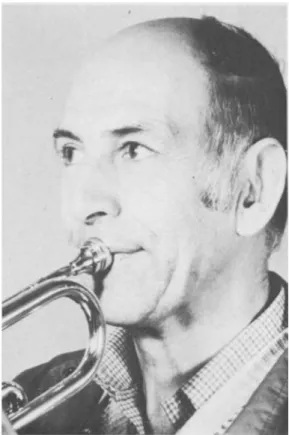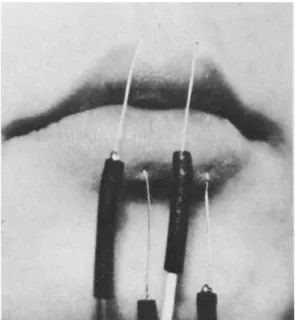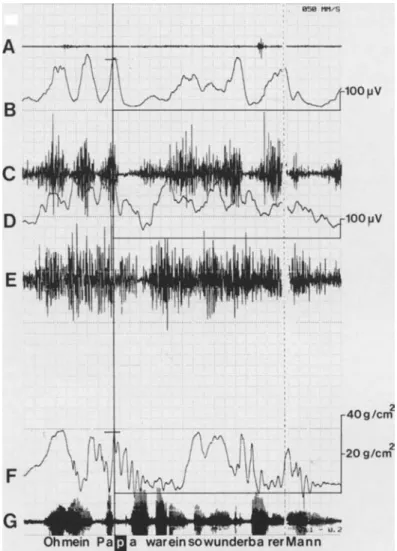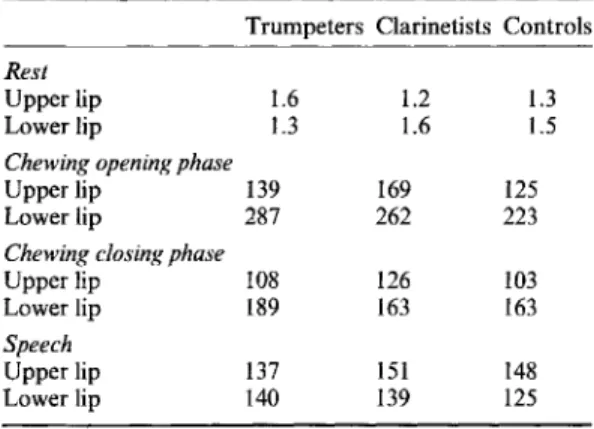Natural lip function in wind instrument players
Susanne Fuhrirnann. Andres Schupbach, Urs Thuer and Bengt Ingervall
Orthodontic Clinic, University of Bern, Switzerland
SUMMARY The lip strength, lip muscle activity, pressure from the lips on the teeth and the morphology of the face and the dentition were studied in professional wind instrument players. Twelve trumpeters and twelve clarinetists, aged 19-55 years, were compared with a control group of dental students.
The lip strength was measured with a dynamometer. Electromyographic measurements of the lip muscle activity and recordings of the pressure from the lips on the front teeth were made in the rest position, during chewing and speech and during playing of the instrument. The mor-phology was studied with x-ray cephalometry and on dental casts.
There were practically no differences between the two groups of musicians or in relation to the control group. Thus, the musicians had the same lip strength, the same muscle activity of the lips and the same pressure from the lips on the teeth during natural functions as did the control group. The pressure from the soft tissues on the teeth during playing of the instrument was considerably greater than during natural lip function but no effect on bite morphology was discernible.
Introduction
The results of recent studies of the effect of lip muscle training are inconclusive. Lip exercises performed by children with incompetent lips were shown to bring about small, positive changes in lip size and lip function but did not
affect the tooth position (Ingervall and Ehasson
1982). Training of the lips with an oral screen, on the other hand, did not affect the lip mor-phology or the natural function of the lips but was shown to increase the strength of the lips
(Owman-Moll and Ingervall 1984). It is not
known whether the increase in maximal lip strength results in a greater pressure from the lips on the teeth, which might increase the stability of a treatment result.
Wind instrument players provide an oppor-tunity to study the effect of lip muscle training. Professional musicians playing a wind instru-ment have for many years been using their lips
intensively for several hours per day. It seems
reasonable to assume that the lip strength of such musicians should be above average. This could also have an effect on the natural function of the lips and the pressure from the lips on the teeth.
This investigation was performed to compare the lip strength and the function of the lips in
the rest posinon, during chewing and during speech of wind instrument players with the same functions in a control group.
Two groups of wind instrument players were chosen, trumpeters and clarinetists, partly on grounds of availability, partly because the lips are used differently in playing these two instru-ments. When playing the trumpet, both lips are tense (Fig. 1) and vibrate from the stream of air passing between them into the mouthpiece of the trumpet. The clarinet rests on the lower lip, which is positioned over the edges of the lower incisors while the upper lip forms a seal over the upper incisors against the upper part of the mouthpiece (Fig. 2).
Subjects and methods
Twelve trumpeters and 12 clarinetists took part in the investigation. They were compared with a control group of 12 dental students. The sub-jects' age and sex distributions are given in Table 1. The musicians were studying at the music school of Bern, Switzerland or had passed their final examination at the school. All were playing their instrument professionally. The only cri-terion for the selection of the subjects among the musicians and dental students was willingness to participate in the study.
Figure 1 Lip position during playing of the trumpet.
Measurement oflip strength
The strength of the lips was assessed with a pom-meter as described by Posen (1972, 1976). The same instrument and method have been used in several investigations by the present authors (see Thiier and Ingervall 1986). The instrument con-sists of a mouthpiece connected to a dyna-mometer, which registers a traction force in grams when the mouthpiece is drawn from the lips (Fig. 3). The maximum force is registered in grams, (Porn-value) with which the lips can resist the mouthpiece being pulled loose from the grip between the lips. The median value of nine
Table 1 Age (years) and sex of the sub-jects studied.
Age
Men Women Median Range
Trumpeters 11 1 27 19-55
Clarinetists 10 2 27 22-36
Controls 11 I 25 23-26
Figure 2 Lip position during playing of the clarinet.
recordings was used as the measurement of lip strength.
Measurement of lip muscle activity
The state of rest of the lips and their activity during chewing, speech and simulated playing were recorded with a DIS A electromyograph. Bipolar hook electrodes (Ahlgren 1967) were
border of the upper and lower red lip, respect-ively (Fig. 4). A similar electrode was placed as
described earlier (Thiier et al. 1985) over the
right masseter muscle and was used to ascertain the phase of the chewing cycle.
Measurement of lip pressure
The pressure from the lips on the teeth was recorded simultaneously with the electromyo-graphic registration in the midline between the upper and lower central incisors (upper and lower lip pressure) and in the right modiolus region (point of measurement in the space be-tween the upper cuspid and first premolar).
The recordings were made with the water-filled system incorporating an extra-oral
pres-sure transducer described earlier (Thiier et al.
1985, Thiier and Ingervall 1986). As the intra-oral measuring point, an open cannula is used which is located buccally, level with the gingival papilla (Fig. 5).
Figure 4 Placement of the electrodes for the recording of lip muscle activity.
The measurements of lip strength, lip muscle activity and lip pressure were made with the same equipment and with the same methods as
described in detail earlier (Thiier et al. 1985,
Thiier and Ingervall 1986), the only difference being the use of hook instead of surface
elec-Figure 5 Mouthpiece used for the recording of upper lip pressure.
trodes. This change was necessary because many of the subjects wore a beard or a moustache.
Recording protocol
(1) Recording of lip strength.
(2) Simultaneous recording of muscle activity (upper and lower lips and masseter) and lip pressure at the upper or lower midline or at the modiolus in random order-(a) in the rest position of the mandible and
lips;
(b) during the chewing of crispbread; (c) during the articulation of the phrase 'Oh
mein Papa war ein so wunderbarer Mann';
(d) in the musicians during simulation of the playing of the tone 'a';
(e) new recording in the rest position; (f) in the musicians during the playing of the
tone 'a'.
The resting lip pressure and muscle activity were measured when the electromyographic (EMG) activity was minimal for at least 5 seconds. Two measurements were made at each of the record-ings 2a and 2e. The means of these determi-nations were recorded as lip muscle activity (mean voltage amplitude in f.lV) and lip pressure (in grams) in the rest position.
The maximal mean voltage amplitude of the EMG-activity of the upper and lower lips and the maximal lip pressure were determined during the opening and closing phases of the chewing cycle (as judged from the EMG-activity of the masseter muscle). The mean value of 12 ran-domly selected chewing cycles was calculated.
A ----...
--"--+--.----..--...w.t-...---B
,
: :
j - - - ; ' - - ; - - - . , . . - - 'c
D
F
G
100fJV 409tcnfFigure 6 Electromyographic and lip pressure recording of the phrase 'Oh mein Papa war ein so wunderbarer Mann'. A: Direct recording of masseter muscle activity. B: Mean voltage recording of upper lip activity.C:Direct recording of upper lip activity. D: Mean voltage recording aflawer lip activity. E: Direct recording aflawer lip activity. F: Lip pressure.
The phrase 'Oh mein Papa war ein so wunder-barer Mann' was articulated twice and the lip pressure and lip muscle activity at the second 'p' in the world Papa were measured (mean of two recordings). To identify the place of measure-ment the phrase was recorded with a micro-phone simultaneously with the recording of the lip pressure (Fig. 6). For the recording 2d, the subject tried to hold the lips in a position corres-ponding to the one he would have used when playing the tone 'a' on his instrument. The mean voltage activity of the lips and the lip pressure were recorded and measured at 8 points on the paper recording. The mean value was calculated.
In the musicians, the recording of lip pressure during the actual playing of the tone 'a' was made without the electromyographic electrodes and with either the upper, the lower, or the modiolus pressure-measuring mouthpiece in place. This procedure was used in order to avoid the reinsertion of the electrodes. Thus, four re-cordings of' upper lip pressure, four of lower lip pressure and four of modiolus pressure were made in each of the two groups of musicians. The mean of 8 measurements on the recording strip was calculated.
In order to determine the errors of the method for the recordings of the lip muscle activity
pression of lip strength.
Mean S.d. Median Range
which were also used to ascertain the Angle class.
Biometric recordings
From profile cephalograms, the same variables
as were used by Thiier et al. (1985) and Thiier
and Ingervall (1986) to describe the morphology of the face, the dentition and the lips were meas-ured.
Overjet and overbite were determined by the and pressure, they were performed twice in the control group with an interval of 2-6 months between the two occasions. Only three small systematic differences between the duplicate determinations were found (for two EMG vari-ables and one lip pressure variable). The mean values of the two recordings of the control group were used in the further analyses. The random errors of the method were for the majority of the variables somewhat smaller than those found
in children (Thueret al. 1985).
Trumpeters 318 Clarinetists 291 Controls 300 80 315 101 270 106 293 200-500 150-430 250-545 Statistical methods
Systematic differences between the duplicate
determinations were tested with a paired t-test.
The random errors(Si)were calculated with the
formula Si = v(L'd2/2n), where d is the
differ-ence between the two determinations. Differ-ences between the three groups were tested with the Mann-Whitney U-test and differences within the groups with Wilcoxon's matched-pairs signed-ranks test.
Results
The lip strength in the three groups is given in Table 2. There was no difference in the Pom-values between the three groups. The lip pressure during the various functions studied is shown in Table 3. There were no significant differences between the three groups in lip pressure in the rest position or during chewing. Only one signifi-cant difference was found during the speech recording; the lower lip pressure was lower (0.01<P<0.05) for the clarinetists than for the
Table 3 Median and range (in gjcm2) of the pressure recorded at the lips and in the
modiolus region in various lip functions.
Trumpeters Clarinetists Controls
Median Range Median Range Median Range
Rest
Upper lip 2.8 -3.8-5.9 1.1 -1.6-7.8 0.5 -1.9-5.8
Modiolus 3.9 0.5-11.2 4.9 0.6-12.8 2.9 0.0-6.2
Lower lip 0.6 -2.2-22.8 0.8 -1.7-7.7 4.0 -3.3-10.7
Chewing opening phase
Upper lip 25 10-66 23 12-53 27 13-60
Modiolus 41 8-118 30 17-159 35 19-59
Lower lip 144 18-360 128 62-328 161 54-464
Chewing closing phase
Upper lip 25 7-51 18 6-43 20 12-66 Modiolus 36 8-108 30 11-146 29 16-52 Lower lip 79 14-376 74 42-322 121 42-524 Speech Upper lip 23 7-60 24 7-71 30 6-62 Modiolus 57 23-85 45 24-204 40 20-181 Lower lip 30 3-163 22 15-84 38 23-74 Simulated playing Upper lip 69 7-243 51 9-200 Modiolus 111 48-254 66 8-219 Lower lip 47 8-111 32 16-207
Trumpeters Clarinetists Controls
Table 4 Number of individuals with nega-tive resting lip pressures.
Trumpeters Clarinetists
Median Range Median Range
Table 5 Median and range (in g/cm") of the pres-sure recorded during playing of the instrument.
Table 6 Median value (inflV)oflip muscle activity in the rest position and during chewing and speech.
Trumpeters Clarinetists Controls
Rest
Upper lip 1.6 1.2 1.3
Lower lip 1.3 1.6 1.5
Chewing opening phase
Upper lip 139 169 125
Lower lip 287 262 223
Chewing closing phase
Upper lip 108 126 103
Lower lip 189 163 163
Speech
Upper lip 137 151 148
Lower lip 140 139 125
The lip muscle activity during the recordings of the lip pressure is shown in Table 6. The mean values of the median activity during the three pressure recordings (upper and lower lips and modiolus) are given in the Table.
There was only one significant difference be-tween the groups. The upper lip activity in the opening phase of the chewing cycle during recording of the upper lip pressure was greater in the clarinetists than in the control group (0.01 <P<0.05). Otherwise, the lip activity was very similar in the three groups, as is evident from Table 6. Among the 28 biometric variables tested, only one showed a significant difference between groups. Thus, in the trumpeters, the lower lip covered on average only 2.2 mm of the upper incisors, compared to 3.6 mm in the control group (0.01 <P<0.05).
Discussion
The errors of the method used for the recording of lip pressure and lip muscle activity, evaluated in the control group, were generally smaller than those previously found in the recordings in chil-dren (Thiier et al. 1985). The intra-individual variations in the values recorded are likely to be of a mainly biological nature and not due to the
method of recordingper se (Luffingham 1968,
Thiier et al. 1985). The intra-individual vari-ations are presumably the same in all three groups studied and should therefore not pre-clude comparison between them.
The lip strength of the subjects studied was considerably greater than in previous studies of
88-170 104-677 172-278 5 2 3 5 220-866 121 44-170 125 105-595 229 Upper lip 2 Lower lip 3
controls. There was no significant difference in lip pressure between the trumpeters and the clarinetists during simulated playing.
In the group of clarinetists, the resting lip pressure measured at the modiolus was higher (0.001 <P<O.OI) than the lower lip pressure, and in the control group the upper lip resting pressure was lower (0,01 <P<0.05) than the modiolus and lower lip pressures. No such sig-nificant differences were found in the trumpeters. In all three groups, there were some individuals with negative upper or lower lip resting pressures (Table 4) but none with a negative pressure in the modiolus region.
The distribution of the pressure during chew-ing was similar in all three groups, the highest pressure being recorded at the lower lip, fol-lowed by the modiolus region.
The pressure in the speech test was rather simi-lar at all three places of measurement in the control group while in the two groups of musi-cians the pressure tended to be higher in the modiolus region. In the group of trumpeters, there was a significant (P<O.OOI) difference be-tween the upper lip and the modiolus and in the group of clarinetists between the lower lip and the modiolus (0.001 <P<O.OI).
The pressures measured during simulated playing are not representative of the pressures recorded during the actual playing of the instru-ments. The pressures measured during playing were as a rule considerably greater than those recorded during simulation (Table 5). As for the other pressures measured, the range of the values recorded is impressive.
Upper lip (n = 4) 524 Modiolus (n = 4) 86 Lower lip (n = 4) 188
(Ingervall and Janson 1981, Owman-Moll and Ingervall 1984, Thiier and Ingervall 1986). In unselected children around 10 years of age, the Porn-value was found to be on average 173-210 g and to be correlated with age (Ingervall
and Janson 1981, Thiier and Ingervall 1986).It
is thus not surprising that the lip strength was higher in this group of adults. More interesting is the lack of difference between the three groups studied. The intensive use of the lips by the mu-sicians has evidently not resulted in an increased lip strength, although this can be accomplished in children with incompetent lips by training with an oral screen (Owman-Moll and Ingervall
1984).Itmay be that such training is only
pos-sible in growing individuals or that the type of exercise is decisive.
The average pressure from the lips on the teeth in the rest position was the same in the present
subjects as in children (Thiier et al. 1985, Thiier
and Ingervall 1986) when recorded at the modiolus but was smaller at the lower lip and in the groups of clarinetists and controls also at the upper lip. Despite the increased lip strength of the present subjects in comparison with children, the pressure from the lips on the teeth thus tends to be lower. This confirms earlier findings of the independence of lip strength and lip pressure (Thiier and Ingervall1986). The observations of the lip muscle activity in the rest position, paral-lel those for the lip pressure, with smaller values
in the present groups than in children (Thiieret
al. 1985).
The lip pressure during chewing tended to be smaller in this group than in children when recorded at the upper lip and in the modiolus region but was the same when recorded at the lower lip. The lip muscle activity during chewing closely paralleled that found in children (Thiier
et al.1985, Thiier and Ingervall 1986).
Different types of electrodes were, however, used in this investigation and in the studies of children, where the recordings were made with surface electrodes.
It is interesting that the pronunciation of
the bilabial explosive 'p' resulted in the same amount of pressure from the upper lip on the teeth and from the modiolus even greater than was produced during chewing. The lower lip, however, was more active during chewing. The upper lip muscle activity was equally great dur-ing speech and chewdur-ing.
pressure from the lips on the teeth and lip muscle activity show no effect of the wind instrument playing, either in comparison with the present control group or compared with children studied earlier. The claims by Parker (1957) and Herman (1981) that wind instrument playing develops and increases the tonicity of the lip muscles could thus not be substantiated.
The pressure recorded from the upper lip in this study during the playing of the trumpet cor-responds very closely to that found by Engelman (1965). The pressure during the playing of the clarinet was, however, smaller in the present study than in that of Engelman (1965). This dif-ference is probably due to methodological differ-ences. Engelman used an oral shield in the upper vestibular fold for his recordings. This shield probably extended more from the teeth than the mouthpiece used in the present investigation. The upper lip was therefore more extended in the study of Engelman, which would influence the pressure recorded during the playing of the clarinet but not during the playing of the trumpet.
The pressures recorded during playing of the instrument were considerably greater than those found during both chewing and speech. Despite this, no effect on the dentition was found. All three groups were rather similar with respect to facial and bite morphology. This is in contrast to other reports where the playing of wind instruments has been shown to produce minor changes of the incisor relationships (Gualtieri 1979, Herman 1981). An explanation may be that professional musicians, like the subjects studied, often play several wind instruments, the influence of which on the dentition may be in
different directions. It must also be taken into
consideration that the groups studied were small and hence did not reveal possible small morpho-logical differences between them.
In conclusion, this study of two groups of professional musicians playing two different in-struments revealed no difference between them, or in comparison with a control group, regard-ing lip morphology, lip strength, lip muscle ac-tivity or pressure from the lips on the teeth during natural functions in spite of intensive use of the lips in wind instrument playing. This shows that lip muscle exercises, in order to be effective, must be specifically directed towards a certain goal. Whether such exercises will change
the pressure from the oro-facial soft tissues on the teeth still remains to be proven.
Acknowledgement
This study was supported by Schweizerischer Nationalfonds zur Forderung der wissenschaft-lichen Forschung (Grant Nr. 3.832-0.83).
Address for correspondence
Dr Drs Thuer
Klinik fur Kieferorthopadie Freiburgstrasse 7, CH-3010 Bern Switzerland
References
Ahlgren J1967An intercutaneous needle electrode for kin-esiologic EMG studies. Acta Odontologica Scandinavica
25: 15-19
Engelman J 1965Measurement of perioral pressures during playing of musical wind instruments. American Journal of Orthodontics51: 856-864
Gualtieri P 1979May Johnny or Janie play the clarinet? American Journal of Orthodontics76: 260-276
Herman E1981Influence of musical instruments on tooth positions. American Journal of Orthodontics80: 145-155
Ingervall B, Janson T1981The value of clinical lip strength measurements. American Journal of Orthodontics 80: 496-507
Ingervall B, Eliasson G-B1982Effect of lip training in chil-dren with short upper lip. Angle Orthodontist 52: 222-233
Luffingham J K 1968Pressure exerted on teeth by the lips and cheeks. Transactions British Society for the Study of Orthodontics54:103-106
Lundstrom A1948Tooth size and occlusion in twins. Basle, Switzerland, S. Karger .
Owman-Moll P, Ingervall B1984Effect of oral screen treat-ment on dentition, lip morphology, and function in children with incompetent lips. American Journal of Orthodontics85: 37-46
Parker J1957The Alameda instrumentalist study. American Journal of Orthodontics43: 399-415
Posen A L 1972The influence of maximum perioral and tongue force on the incisor teeth. Angle Orthodontist42: 285-309
Posen ALI976The application of quantitative perioral assessment to orthodontic case analysis and treatment planning. Angle Orthodontist46: 118-143
Thiier D, Janson T, Ingerall B1985Application in children of a new method for the measurement of forces from the lips on the teeth. European Journal of Orthodontics 7:
63-78
Thiier D, Ingervall B1986Pressure from the lips on the teeth and malocclusion. American Journal of Orthodontics90: 234-242




